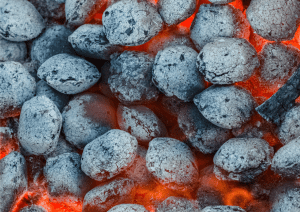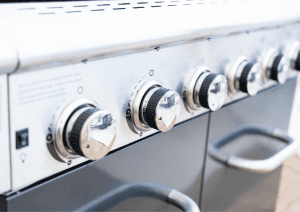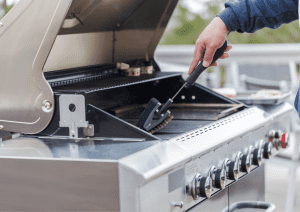Do you want to know how to make your gas grill hotter and at the same time prevent it from damaging your barbecue? You need to pay attention to some specific guidelines. It is also essential to know that the hotter the grill, the faster the BBQ will cook, so you must adjust the timing to avoid overheating and burning.
Whether you want to use your gas grill on higher altitudes or to sear your burgers, steaks, or chicken, you can do a few things to make your grill hotter and more efficient to use. By practicing the things mentioned in this article and maintaining your barbecue grill, you’ll achieve the results you expect.
But before we go, it’s time to answer a few questions about why your gas grill won’t heat enough. Getting it not hotter can be because of some technical issues. Well, the time is to shed the worries and find out the exact ways to get higher hotness on your gas grill.
Why Won’t your Gas Grill Get Hot Enough?
There might be several problems that could prevent your grill from heating enough for the barbeque. However, here are some of the most important ones.
1. Clogged Hose
The first cause of low temperature on a grill can be a kinked or clogged hose. A kinked hose may be the only thing blocking the gas to the burners and preventing the grill from heating completely. Examine the gas line and the hose between the tank and the burner to clear any kinks.
2. Faulty Gas Grill Regulator
If you don’t see any kinks in the hose, you may need to reset your gas grill regulator. In most cases, resetting the regulator can solve the problem of underheating.
3. Unblock the Grill Burner Tube
Your gas grill can fail to get enough heat and trouble you during cooking, especially when the burner tubes need to clean. You can get an efficient burner with even flames. As a result, your grill will offer you excellent heat. You can know how to clean gas grill burner tubes here.
How to Make Gas Grill Hotter: Expert Tips

When everything is fine about the health of your gas grill, the time is perfect for trying out some DIY solutions about how to make it hotter. These are here.
-
Add Grill Bricks
Piling grill bricks around the gas lines of the grill will increase the temperature of the barbecue. It’s because the bricks conduct the heat from the gas and add more warmth to the cooking process, allowing the recipes to cook faster and at a higher temperature. Don’t pile the bricks too high; use only one layer to ensure even cooking.
-
Use Lava Rocks

Lava rocks offer improved performance for gas fire pits. Lava rocks heat and radiate heat more uniformly than a bare flame coming directly from the burner. In addition, lava rocks protect gas burners from oil, grease, and other contaminants from cooking.
Follow these steps to safely place lava rocks inside your grill:
- First, you will need expandable grates that will adequately cover the burners of your barbecue and enough lava rocks to form one solid layer on top of them.
- Remove the cooking grates you already have on your grill and cover the burners with the newly purchased expandable grates.
- Place a solid, single layer of lava rocks on the grates. Replace the cooking grates you removed and turn the burners on. Close the lid of your grill while it heats.
- It will take about 20 minutes for the grill’s temperature to reach a temperature of at least 500 degrees Fahrenheit. Since lava rocks trap and retain the heat, the hotness will not drop suddenly when the lid is opened.
After several uses, the lava rocks will be coated with fat, so flip it over as needed. Depending on how often you bake, you may need to replace the lava stone every few months.
-
Turn Up the Heat

As long as the grill is clean, you can increase the gas quantity to fire it up or use the grill’s knob or switch to increase the heat. See your grill’s instruction manual for the proper temperature for different types and cuts of meat.
Veggies need to be cooked at a lower temperature, so turn the heat down for them. Try practicing with more food until you get a good idea of the warmth.
-
Preheat your Grill Properly
Before cooking, make sure the grill is fully heated. Not only will this ensure that it is hot, but it will also ensure that your barbecue is cooked uniformly and correctly. It usually takes 15 to 20 minutes for the grill to heat up, so you can ignite it and close the lid for preheating while you’re sifting through your favorite grilling recipes.
-
Use Tin Foil to Wrap the Food
You can also get a suitable temperature for your food internally. To raise the food temperature, tin foil can be much helpful. As the heat of the gas rises, the heat will be transferred uniformly through the foil, and the barbecue will heat up faster.
However, if the grill temperature is too high, your dinner may get burnt, so keep an eye on it. In the end, it’s reasonable to answer a few questions that relate to our topic.
-
Keep Your Grill in Excellent Condition

Maintaining a gas grill is very important. Clean it after every use to prevent fires caused by dry grease and residue and keep the way clear for the heat. Burnt oil and residue can be easily removed by washing off while it is still warm. It is important to be careful not to burn yourself.
Also, ensure that you have enough gas for you to grill. If there is not enough gas, the grill may not be able to generate enough heat.
FAQs
When it’s’ about getting your gas grill hotter, certain questions about the solutions can demand an answer. So, here are the answers.
How do you fix a low flame on a gas grill?
First, turn everything off, including the gas flow in the propane tank. Remove the regulator from the propane tank and let it sit idle for about 5 minutes.
Connect the regulator back to the propane tank and open the valve slowly and fully. Wait about 30 seconds, and then try to light the grill again. In most cases, it will fix the issue of a low flame on your gas grill.
Why doesn’t my Weber grill get hot enough?
If your Weber propane grill is not getting hot, normally it’s because you may have accidentally activated the bypass safety mechanism on the gas regulator. To let it resume its normal operation, you have to follow a proper sequence of actions. Start by turning on the gas in the tank and wait a minute or two until the pressure in the tank and hose equalize. After that, turn on the burner and ignite it as usual.
How do I know if my gas grill regulator is going bad?
Even if your grill is on “high” heat, the temperature will get lower over time. The main indicator that you need a new regulator is low heat or low flame, especially if it gets progressively worse over time.
Why don’t you use lava rocks in gas grills?
Lava rocks absorb and radiate heat, depending on the strength of the burner. Lava rocks have enough surface area to evaporate the gravy and provide fairly even heat. Yet, because lava rocks are porous, they absorb gravy and grease like a sponge, and there is no way to clean them. However, the best practice can be to replace them after some time.
Why is my Char-Broil grill not heating up?
If grease or drippings fall under the grill, the drippings will clog the pores and prevent the gas from flowing properly. To clean the burners, try using a grill brush to dislodge the drippings from the interior and exterior of the burners. If the blockage is severe, the burner may need to be replaced.
How can I make a charcoal grill hotter?
The answer is simple: by regulating the airflow you can make charcoal grills hot for your BBQ.
On most charcoal grills, unlike gas grills, there is a vent on the bottom. If you open the vent wide, there will be more air, and the fire will get hotter. Partially closing the vent will reduce the amount of air, resulting in a low flame. When lighting the charcoal and setting up the grill, make sure the vents are open.
Final Thoughts
If you’ve been wondering how to make your gas grill hotter, you can make the best use of it for your BBQ by using the above-mentioned techniques. Yet, make sure you do it step-by-step. First, check your gas grill not getting hot enough for technical reasons. If everything is excellent, then try the solutions for temperature enhancement as your find in this article. Do you think the trouble with your grill has been because of some fault? Let us know by commenting below.
universitygrill.net is a participant in the Amazon Associate program and will earn from qualifying purchases.
